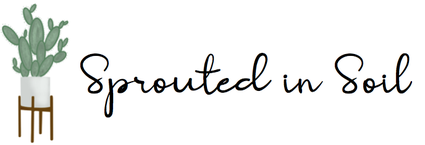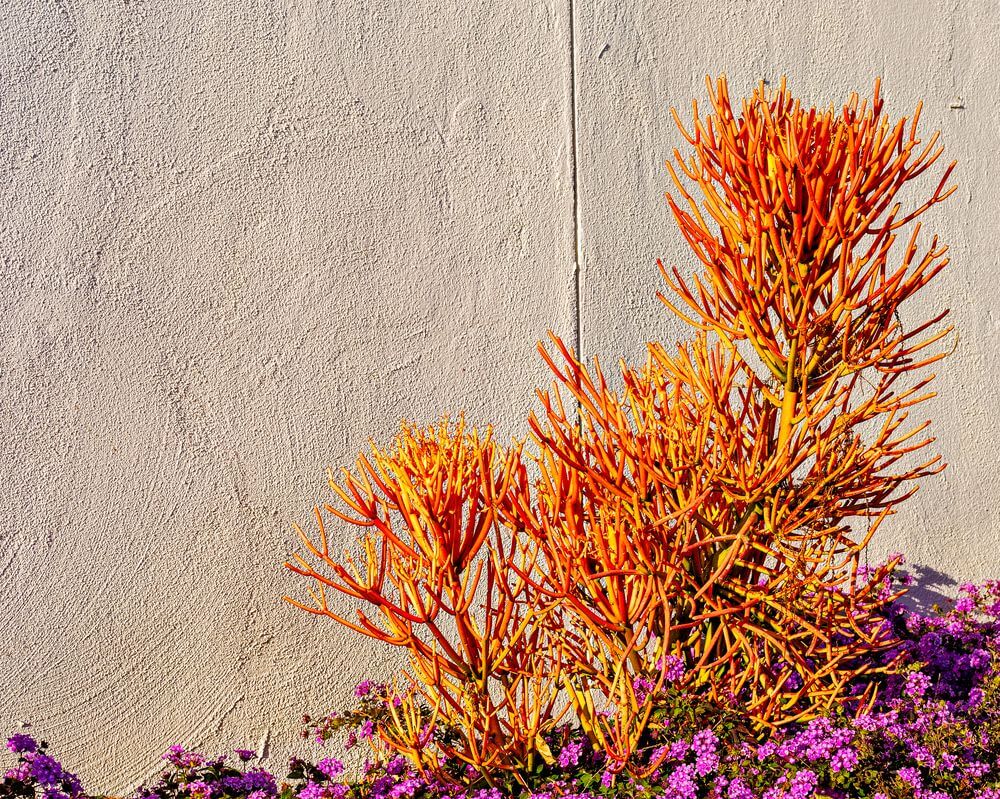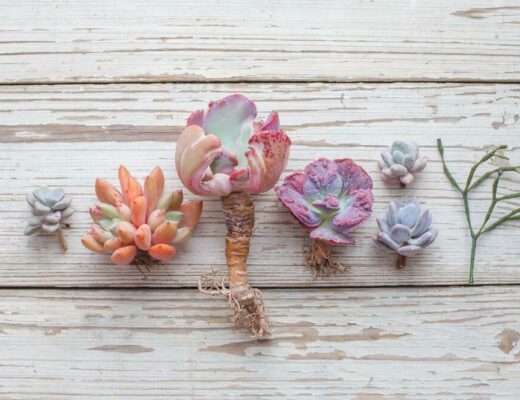When most people think of succulents and cacti, I would bet they think of heat, bright sun and dry climates. While some of these plants do better in partial shade or low light conditions, the majority love being in the sun. In fact, there are plenty of full sun succulents that need direct sunlight for a majority of the day in order to flourish!
Here’s why:
Ample amounts of sunlight is considered a “stressor”. Think of a stressor as an external factor causing a plant to change in different ways to protect itself.
So bright sunlight, in moderation, is a stressor. As a result, a plant’s defensive mechanism is to change colors to protect the soft tissue that makes up the stem and leaves. What we see is a beautiful change in the plant from muted tones to a vibrant show of color.
Not only is full sun needed to enhance these colors, direct sunlight is necessary for certain succulents to perform photosynthesis and create enough energy to grow.
Here is a curated list of sun-loving succulents and cacti that love to be out basking for hours!
1. Agave victoriae-reginae
This is a magnificent and royally beautiful full sun succulent! Bright green leaves are lined with a white margins that create a prism pattern. Leaves grow upright and form a compact rosette that resembles a half dome. This succulent loves six hours of full sun.
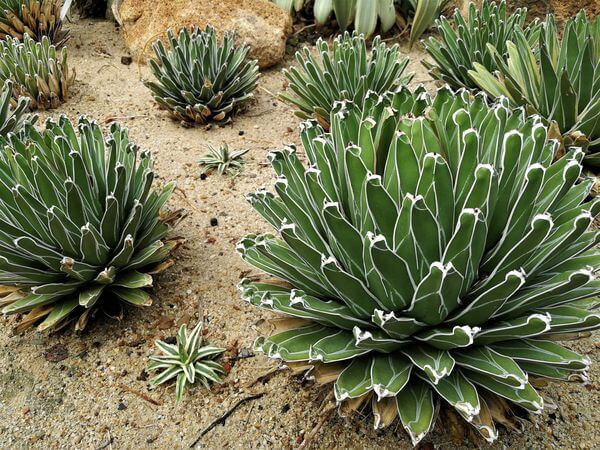
It has water requirements similar to other succulents and needs to be watered more frequently during the hottest summer months despite being native to the Chihuahuan Desert in Mexico. Agave victoriae-reginae is a perfect lawn decoration in warmer, drier climates but does equally as well as an indoor plant as long as it is near a south facing window.
- Mature size – 12′ tall, 18′ wide
- Hardiness – Zone 9a
2. Opuntia microdasys ‘Bunny Ears Cactus’ and Opuntia microdasys ‘Angel Wing’
These two cacti are two similar varieties and are some one of my absolute favorites. Both grow oval, pad-like leaves with fine, hairy spines. While ‘Angel Wing’ has leaves that are a medium forest green offset by the white hairs, ‘Bunny Ears’ displays a lime green color on younger leaves that mature to a deeper, richer green.
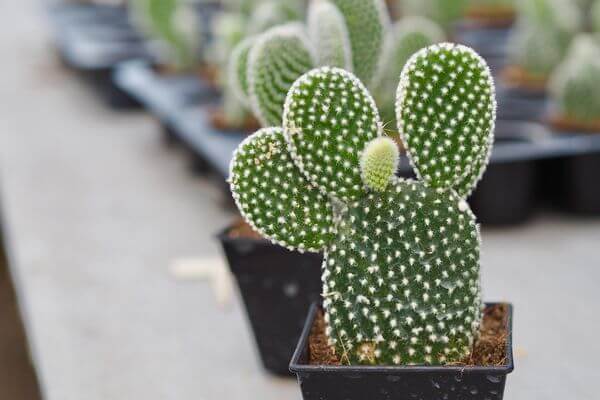
You will make this cactus happy in full, direct sunlight and by providing it with deep but infrequent waterings. These cacti produce yellow flowers under the right conditions. Your best chance is growing both of these cacti outside in a climate with mild winters averaging between 45-55 degrees F and no frosts. As the days begin to turn warm, the cactus will be encouraged to flower as the season changes to spring.
- Mature Size – 3′ tall, 6′ wide
- Hardiness – Zone 9
3. Euphorbia tirucalli ‘Fire Stick’
This succulent is so fun! Not only is the color mind blowing when grown in full sun but so is it’s mature height. This cactus can reach up to 20 feet tall! ‘Fire Stick’ is a drought tolerant tree succulent and does best outside in temperatures between 50°F – 70°F.
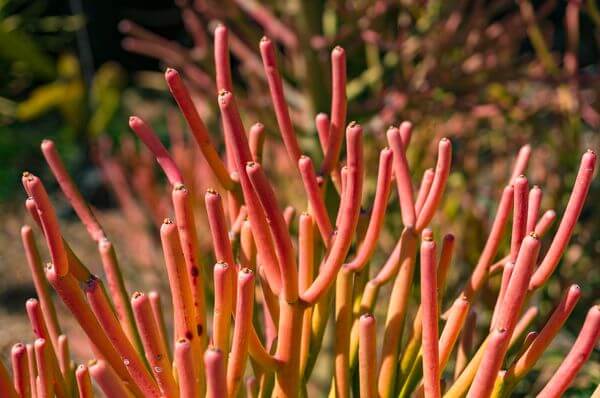
Water sparingly whether it is grown outside in your garden or inside as a houseplant. Ensure that it is planted in coarse, well-draining soil. When handling, it is important to only touch this succulent with gloves because the sap is toxic and extremely irritating.
- Mature Size – up to 20’
- Hardiness – Zones 10-11
4. Senecio mandraliscae ‘Blue Chalksticks’
Perfectly named, this succulent boasts tapered leaves with a chalky, powdery blue hue that grow in clumps. S. mandraliscae is a great option if you are looking to plant eye-catching ground cover in your garden.
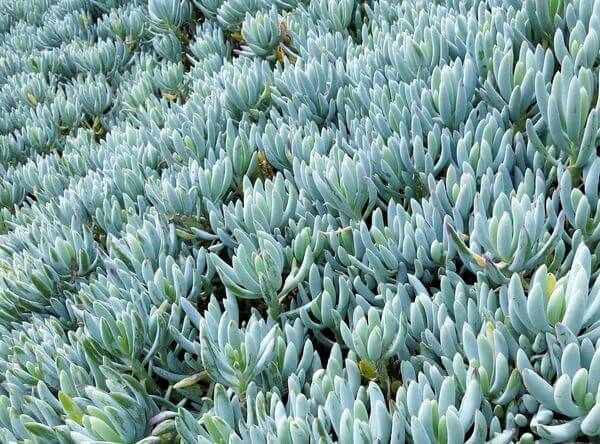
S. mandraliscae is native to the Cape of Good Hope in South Africa but can also be seen on the coasts of California cascading down the cliffs. Despite being close to the ocean, these succulents need little water, and even less so in the winter months.
‘Blue Chalksticks’ can be propagated best by leaf and stem cuttings. Take a sharp, sterile knife and cut either a leaf or stem off the main plant. Allow the end to callous over before replanting in new soil.
- Mature Size – 12+ inches
- Hardiness – Zone 10
5. Sempervivum ‘Red Rubin’
The entire Sempervivum genus loves full sun. In fact, you actually need to grow this plant in full sun in order to enjoy all of the vibrant colors these succulents have to offer. ‘Red Rubin’, as you can guess from its name, has a blushing pink center that fades to a silvery green on the outer leaves.
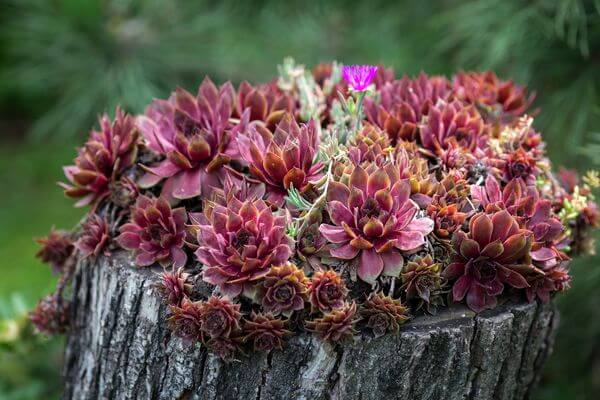
This full sun succulent can be grown indoors in a south facing window or outside in a garden that receives full sun in the morning and early afternoon. Sempervivum, also known as Hens & Chicks, are prolific growers and make for a beautiful ground cover when offsets are propagated.
You can enjoy ‘Red Rubin’ outside in a variety of outdoor climates as it can survive snowy winters. If you do live in a hot climate where summer temperatures frequently exceed 80°F, be sure to water more frequently and protect from harsh late afternoon sun.
- Mature Size – each rosette can grow to 3” tall to 4” wide
- Hardiness – Zones 5-10
6. Kalanchoe thyrsiflora
Also known as a ‘Paddle Plant’ due to its signature flat, wide leaves, Kalanchoe thyrsiflora will bring a glowing third dimension to your collection. With light green leaves that fade into a lively red when grown in full sun, expect this succulent to produce fragrant yellow flowers once it reaches about four years of age.
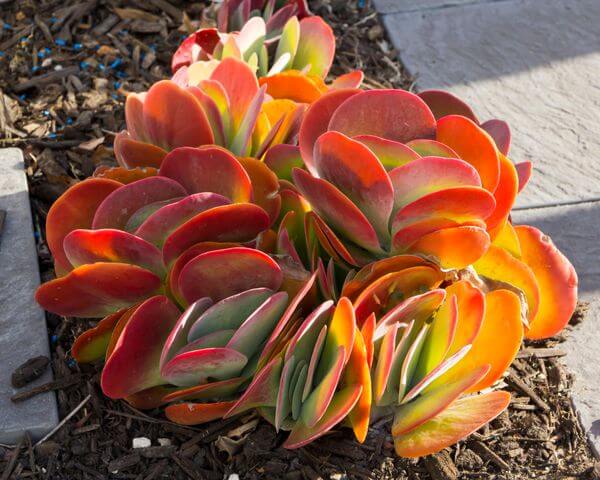
As this full sun succulent grows, new offsets will sprout up around the base. So while the ‘Paddle Plant’ is monocarpic, meaning that the individual rosette will die after flowering, you will get to enjoy this plant’s offsets for years to come.
Kalanchoe thyrsiflora requires minimal water and even less so in colder months. Whether planted in a pot or outside in the ground, ensure the soil is gritty and well draining.
- Mature Size – over 12” tall
- Hardiness – Zone 10
7. Pleiospilos nelii ‘Royal Flush’
This mimicry plant may have you fooled! Also known as a split rock succulent, this plant’s unique appearance allows it to blend into its native, rocky environment. The ‘Royal Flush’ succulent is best grown inside unless you live in an extremely arid, desert climate. This allows you to carefully control its habitat, as this full sun loving succulent can be quite finicky.
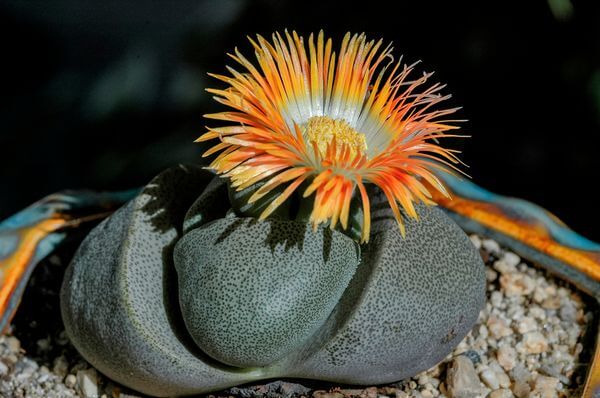
Plant your Pleiospilos nelii in a deep pot to accommodate this succulent’s tap root. The soil should have minimal organic material and be composed mostly of a mix of gritty, mineral materials such as pumice or fine gravel. Water only once every two weeks in the spring and fall and only when the soil is dried through completely.
New leaves appear in pairs, growing from the center of the older pair. As this new pair grows, the old pair will begin to shrivel and die. This is normal. In fact, a healthy ‘Royal Flush’, as it is seen in nature, will only ever have two pairs of healthy leaves at one time. These succulents do not grow in a stacking phenomenon.
- Mature Size – 5” tall, 4” wide
- Hardiness – Zone 10
8. Albuca spiralis ‘Frizzle Sizzle’
How cool is this succulent? With green leaves that twist and coil at the ends, this succulent is reminiscent of fireworks, which perfectly represents its common name, ‘Frizzle Sizzle’.
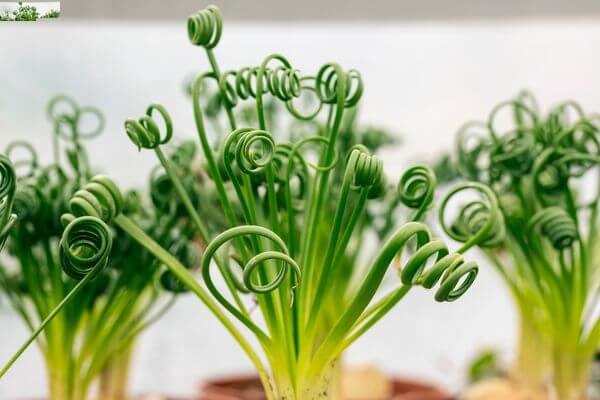
The quirky leaves aren’t the only feature that makes Albuca spiralis unique. This succulent also grows from a bulb. When planting, consider covering only half of the bulb to add additional character to your pot. Remember to place the pot in a window that gets full sun!
To keep your ‘Frizzle Sizzle’ growing like a corkscrew, do not water your succulent after it blooms in the summer. The old leaves will die to leave room for new growth. Only resume watering in mid fall when new leaves begin to appear. Flowers begin to appear in the spring and will fill your house with a pleasant vanilla scent.
- Mature Size – 8” tall
- Hardiness – Zone 10
9. Epithelantha micromeris
Also known as the ‘Button Cactus’ or ‘Ping-Pong Cactus’, E. micromeris is a petite, round cactus with light grey webbed spines. These spines can grow so thick that very little of the fleshy cactus can be seen.
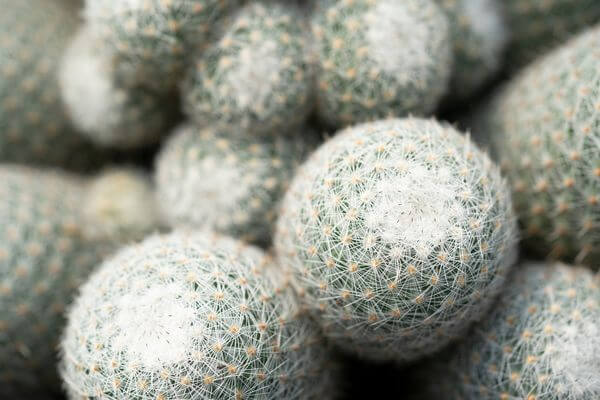
Native to Madagascar, the ‘Button Cactus’ needs exposure to full sun and warm temperatures. It is not cold hardy, so if you live in an area that has cold winters, plant E. micromeris in a pot and bring inside when temperatures begin to dip below freezing.
Water sparingly using the ‘drench and dry’ method, watering more frequently during its growing season in the summer and less frequently in the winter. Propagate via the offsets that grow around the base of the original plant.
- Mature Size – 12” tall, 36”/3’ wide
- Hardiness – Zone 9
10. Fenestraria rhopalophylla
This succulent grows in vertical clusters, sporting thin, finger-like green leaves with rounded tops. Commonly known as ‘Baby Toes’, this succulent has translucent tops on each individual leaf.
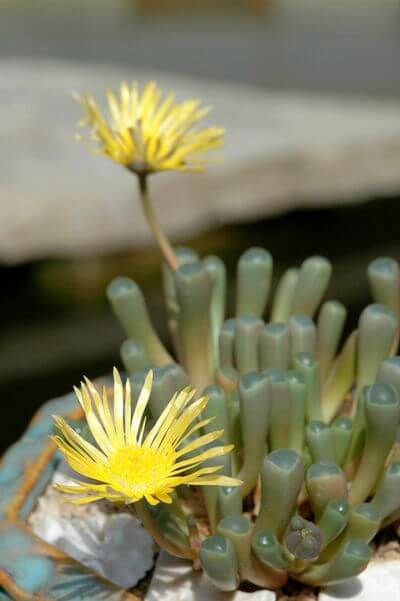
F. rhopalophylla is a slow growing succulent and should be grown in bright, full sun to avoid leggy growth. Water once every 2-3 weeks to avoid leaf and root rot.
- Mature Size – 3” tall
- Hardiness – Zone 10
11. Sedum nussbaumerianum
Sedums are great lovers of direct, full sunlight. Some become a more vibrant green while others, like this ‘Coppertone Sedum’, blush the golden colors of a sunet. ‘Coppertone Sedum’ is best grown outdoors so you get to enjoy its full color potential.
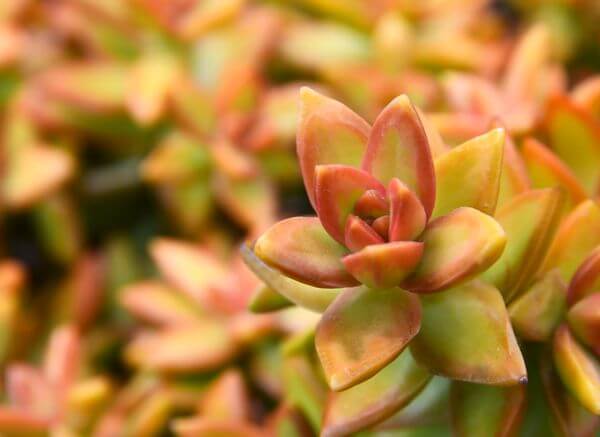
Because the pointed leaves grow in a rosette shape and readily create offsets, S. nussbaumerianum spreads quickly. While some species of sedum are cold hardy, this one is not. It is really only ideal for outdoor gardens in places that don’t get colder than 30°F in the winter months.
This is a great succulent to plant in containers because as they grow, the stems will cascade down the outside of the pot. If you are in a place with cold winters, bring this pot inside and be sure to place in a sunny window that gets 6 hours of sun per day.
Water more frequently in the spring and fall than in the summer but still do so sparingly as sedum can easily be overwatered.
- Mature Size – 8” tall, 36” long
- Hardiness – Zone 10a
12. Orostachys malacophylla var. Iwarenge
Much more commonly known as (and easier to say!) a ‘Chinese Dunce Cap’, this delicate clumping succulent is native to Japan. Leaves are a frosty grey/blue dusted with a light lavender when grown in full sun.
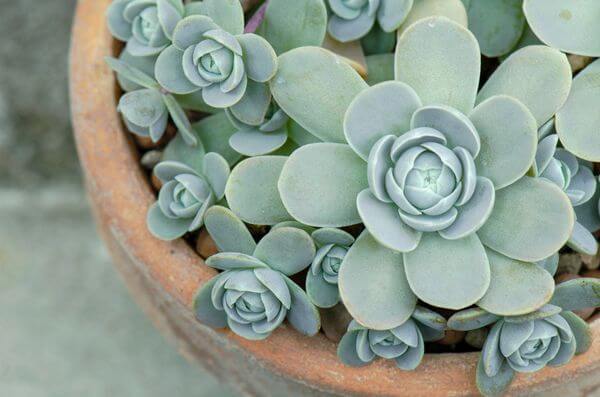
You will see offsets grow in bountiful numbers as this succulent creeps further and further out into your garden. Plant in full sun with well draining soil.
The ‘Chinese Dunce Cap’ actively grows in the summer months. In most climates, as the plant transitions into dormancy in winter, it will begin to die above ground. Don’t worry though, this succulent will grow back healthy beginning in April and May.
- Mature Size – 8” tall with delicate, small rosettes; spreads readily
- Hardiness – Zones 6-10
13. Acanthocereus tetragonus
This columnar cactus is aptly known as ‘Fairy Castle Cactus’. It is a cactus that grows vertically in clumps, creating points that look like the turrets of a castle. The stems are a deep green with 5 sides lined in white spines.
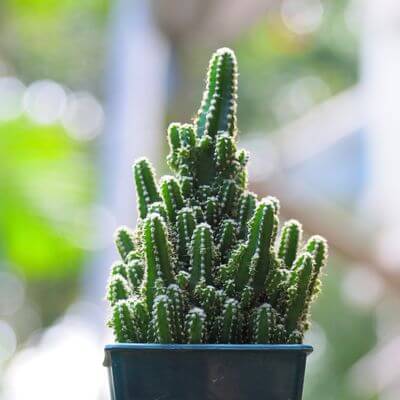
Keep you ‘Fairy Castle Cactus’ inside in a well draining pot on a windowsill that gets at least 6 hours of sunlight per day. Or, if you live in a climate that rarely sees temperatures below 30°F, plant outside and watch it grow up to 6 feet tall! However, I do suggest that you start growing this cactus inside because it grows slowly!
- Mature Size – up to 6’ tall
- Hardiness – Zone 10a
14. Echeveria ‘Dusty Rose’
Like the majority of succulents in the Echeveria genus, ‘Dusty Rose’ does best in full sun. Leaves are a spectrum of color from a cool lavender to an iridescent coral pink. The frosty “dustiness” comes from a powder covering called farina. Farina allows the leaves to tolerate direct sunlight without the risk of sunburn.

Plant in well draining soil and water using the “drench and dry” method. Do not water the leaves to avoid leaf rot.
Echeveria ‘Dusty Rose’ can be easily propagated using offsets, leaves and cuttings. Once this succulent reaches maturity, you can enjoy beautiful coral blooms that shoot out on long stalks from the rosette.
- Mature Size – 5” tall, 8” wide
- Hardiness – Zone 9
15. Sedum ‘Lime Zinger’
This lime green sedum grows low to the ground. Leaves form small rosettes which grow in a creeping, carpet pattern. When planted in full sun, expect to see a sliver of red pop around the margins of each leaf.
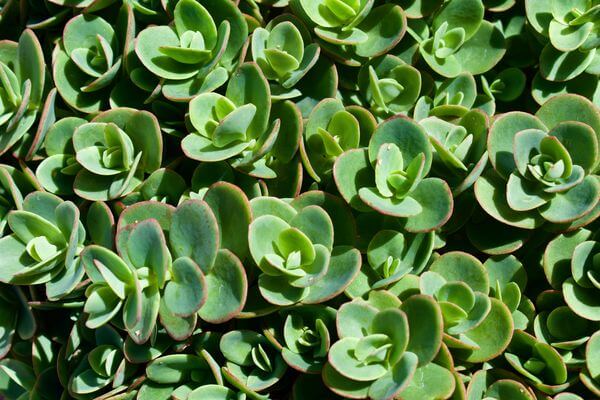
When first planted ‘Lime Zinger’ should be watered regularly, about once a week. As roots begin to spread and mature, this Sedum can withstand a month or more of drought.
This cold hardy, full sun succulent can grow in places that experience temperatures as low as -30°F. As the plant comes back in the spring, you will be excited to see clusters of pink flowers that attract bees and butterflies.
- Mature Size – 3-5” tall; large will be covered when allowed to grow
- Hardiness – Zones 4-10
16. Aloe ‘Lavender Star’
This is a fun species of Aloe with long wedge-shaped green leaves covered in red speckles that create a unique texture. You can enjoy this succulent for a long time without much fuss as it needs very little water and rarely needs to be repotted.

Grow in full sun and protect from frost to keep this succulent happy. Expect orange blooms during winter months.
- Mature Size – 6” tall, 12” wide
- Hardiness – Zone 9b
17. Cylindropuntia fulgida
Also known as the ‘Jumping Cholla’, C. fulgida is a large branching shrubby cactus that is covered with fine barbed spines. This cactus needs full sun in order to grow tall and produce its showy vivid pink blooms.
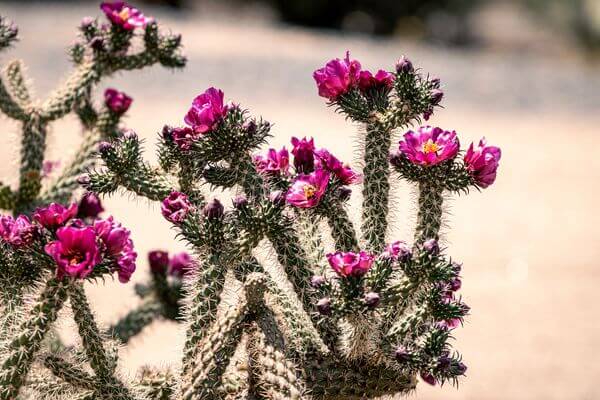
The ‘Jumping Cholla’ is extremely easy to propagate. This characteristic is where this cactus gets its name. Segments of the stem are able to be removed easily and replanted!
- Mature Size – up to 12” tall inside; in the wild, it can grow to over 10’ tall!
- Hardiness – Zones 9-10
Final Thoughts
Full sun succulents will give you an impressive array of colors! They have evolved to be able to tolerate the direct rays and burn less easily than other succulents. When choosing full sun succulents, be sure to pot or plant those with similar watering and temperature needs.
If you want to learn about the other end of the spectrum, check out these low light succulents.
